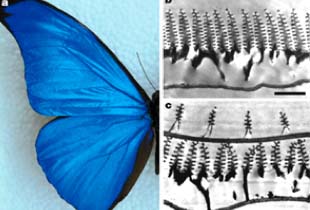Think about a rainbow. Is that a big streak of dyes that someone painted across the sky? No it is the diffraction of light into individual wavelengths that we see as the colors, red, orange, yellow, green, blue and violet. The water droplets in the air are so small that they can diffract light and what we see is light separated into different sizes that differ in just a few hundred nanometers.
Nature is full of pretty neat stuff that have nanometer scale features. Geckos can climb on walls because their toes are covered with nanometer-sized pads that are very sticky. But not too sticky otherwise the gecko would be stuck in one place. So they are sticky enough to allow them to hang upside down, but not they have enough strength in their leg muscles to pull their feet off (one at a time!).
Scientists have been making nanometer scale things that are based upon what we see in nature. This is called biomimetics—-copying things found in nature. It sometimes pays to look at nature for inspiration. After all nature has had a lot of years to practice making interesting nanometer scale things. Looking closely at the feet of geckos, scientists have made the tiny little structures and shown that they could act like sticky tape. No, this stuff isn’t ready for Spiderman but it is getting close. Part of the problem that scientists need to think about is not just the thing that they are going to make but what they are going to make it out of. The current set of gecko-like feet are made from silicon rubber but some day they might figure out how to use materials that are more like what gecko feet are really made from.
Image Source: Nature | Transmaterial

